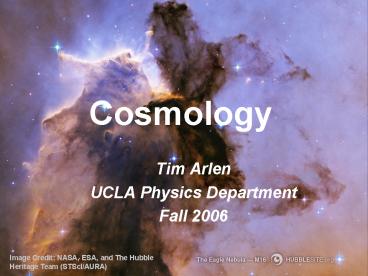Cosmology - PowerPoint PPT Presentation
1 / 23
Title:
Cosmology
Description:
Now if the universe is currently expanding, when we run the clock backwards, the universe should be contracting and eventually should have come from one point. – PowerPoint PPT presentation
Number of Views:125
Avg rating:3.0/5.0
Title: Cosmology
1
Cosmology
- Tim Arlen
- UCLA Physics Department
- Fall 2006
Image Credit NASA, ESA, and The Hubble Heritage
Team (STScI/AURA)
2
Cosmology- study of the overall structure and
properties of the universe as a whole.
Pleiades Star Cluster. Image Credit Robert
Gendler.
3
Topics to Explore
- Highlight history of human thought
- Overview of our current theory
- Do we believe our theory is correct?
Image Credit NASA, ESA, and Martino Romaniello
(European Southern Observatory, Germany)
4
Greek Cosmology
- 400 B.C. Plato and Aristotle
- 5 Elements of the universe Earth, Air, Fire,
Water, and Quintessence. - Earth-stationary, everything revolved around it
in circles.
Image Credit NASA, ESA, HEIC, and The Hubble
Heritage Team (STScI/AURA)
Cats Eye Nebula
5
Greek Cosmology
Image Credit NASA,ESA, M. Robberto (Space
Telescope Science Institute/ESA) and the Hubble
Space Telescope Orion Treasury Project Team
6
More Greek Cosmology
- Ptolemy 200 A.D, geocentric model, Earth is
very small compared to heavens - Based on mathematics planets move in Epicycles
- Taught throughout Middle Ages.
Image Credit NASA, NOAO, ESA, the Hubble Helix
Nebula Team, M. Meixner (STScI), and T.A. Rector
(NRAO)
7
Pre-20th Century Cosmology
- Copernicus, Kepler, and Galileo
- Heliocentric Model
- Advancement of telescope, galaxies discovered
- By end of 19th Century belief in infinite,
static, homogeneous universe.
Image Credit Credit NASA, ESA, S. Beckwith
(STScI) and the HUDF Team
Hubble Ultra Deep Field
8
Birth of Modern Cosmology
- Einstein bursts onto the scene!
- Formulated General Relativity by 1915
- Equations showed that the universe is expanding.
- He didnt like this!
Image Credit NASA, ESA, and The Hubble Heritage
Team (STScI/AURA)
9
Some Gravity Concepts
- Mass affects space by bending it.
- Imagine space in 2D, like a trampoline.
Pleiades Star Cluster. Image Credit Robert
Gendler.
10
Dramatic Comfirmation of GR
- Bending of starlight.
- Confirmed with eclipse in 1916.
Image http//astro.physics.sc.edu
/selfpacedunits/Unit57.html
Image Credit (Cover) Spacetime and Geometry An
Introduction to General Relativity by Sean
Carroll, published by Addison-Wesley.
Image Credit NASA, ESA, HEIC, and The Hubble
Heritage Team (STScI/AURA)
Cats Eye Nebula
11
Expansion of Space
Some Time T
Some Time Later T ?T
12
Hubble and Expansion
- 1929-Hubble demonstrated his famous resultThe
farther away an object is from us, the faster it
moves away from us.
Image Credit NASA,ESA, M. Robberto (Space
Telescope Science Institute/ESA) and the Hubble
Space Telescope Orion Treasury Project Team
13
Modern Cosmology
- Theory of universes origins developed
- Expansion and GR equations imply a beginning,
called singularity - Came to be called Big Bang Theory
- Explosion of space, matter, energy
- Use known laws of physics to reconstruct history
of Universe, predict new phenomena.
Image Credit NASA, NOAO, ESA, the Hubble Helix
Nebula Team, M. Meixner (STScI), and T.A. Rector
(NRAO)
14
Image Credit Credit NASA, ESA, S. Beckwith
(STScI) and the HUDF Team
Hubble Ultra Deep Field
15
Cosmic Microwave Background
- About 300,000 yrs ATB, era of recombination
- Photons can pass through universe unimpeded
- Before this time, universe was a plasma
Image Credit NASA, ESA, and Martino Romaniello
(European Southern Observatory, Germany)
16
Observational Consequences
- Universe itself (space) emits radiation, because
its hot - After Era of Recombination universe is
transparent to photons - Blackbody Radiation predicted- Cosmic Microwave
Background (CMB) in 1960s.
Image Credit NASA, ESA, and The Hubble Heritage
Team (STScI/AURA)
17
Major Discovery
- ATT Bell Laboratory, Penzias Wilson
inadvertently discover background noise in the
microwave region. - Awarded Nobel Prize in 1978
Pleiades Star Cluster. Image Credit Robert
Gendler.
18
Cosmic Microwave Background
- COBE (Cosmic Background Explorer) found that CMB
is uniform (isotropic) to 1 part in 10,000
Image Credit NASA, ESA, HEIC, and The Hubble
Heritage Team (STScI/AURA)
Cats Eye Nebula
19
Problem-Galaxy Formation
- If all matter is spread out uniformly, how could
matter clump together and form galaxies and star
clusters?
Image Credit NASA,ESA, M. Robberto (Space
Telescope Science Institute/ESA) and the Hubble
Space Telescope Orion Treasury Project Team
20
Anisotropy Discovered
- CMB is nonuniform to 1 part in 100,000.
- Slightly denser region of space implies slightly
hotter region of space
Image Credit NASA, NOAO, ESA, the Hubble Helix
Nebula Team, M. Meixner (STScI), and T.A. Rector
(NRAO)
21
Major Discovery
- Slightly hotter (more dense) regions are the
seeds of galaxy formation - Further evidence for dark matter?
- John Mather and George Smoot Awarded 2006 Nobel
Prize in Physics for this work
Image Credit NASA, ESA, and Martino Romaniello
(European Southern Observatory, Germany)
22
Brief Recap
Image Credit Credit NASA, ESA, S. Beckwith
(STScI) and the HUDF Team
Hubble Ultra Deep Field
23
Olbers Paradox
- If the universe was infinite static, then along
any line of sight, you will eventually hit a
star. - Then the night sky should be as bright as an
average star!
Image Credit NASA, ESA, and Martino Romaniello
(European Southern Observatory, Germany)






























